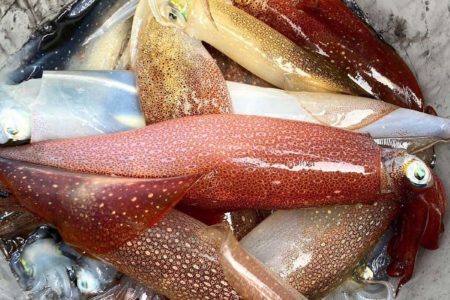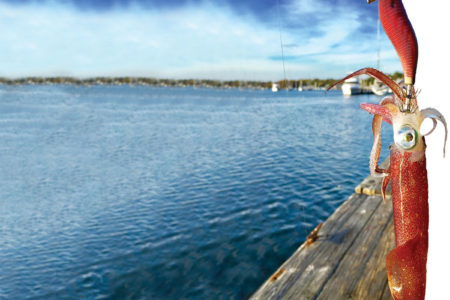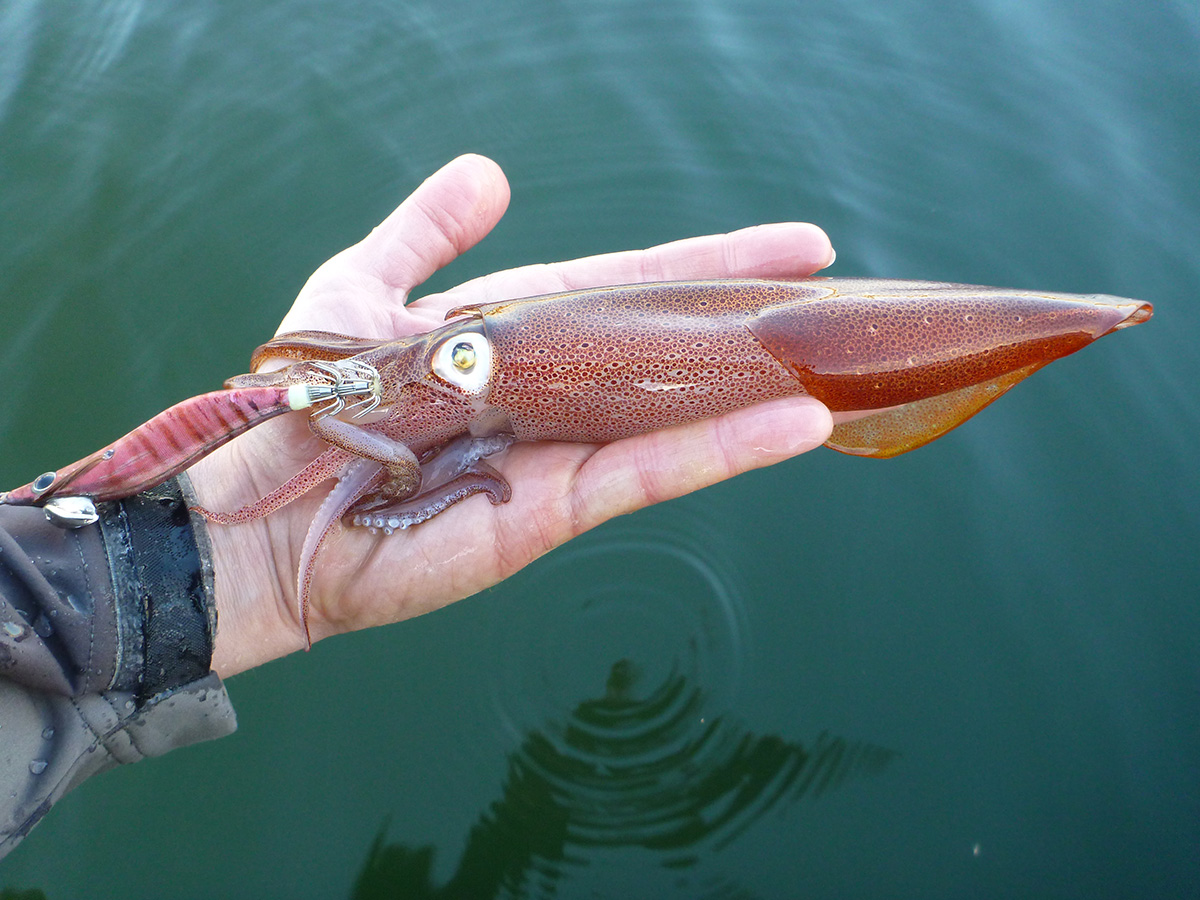
Knowing how to recognize the different types of jigs, as well as how to rig and fish them is essential to success.
Squid are currently my favorite creature to pursue in saltwater. It only took until I was nearly age 50 to learn how to catch them. I attribute much of the reason for this to not knowing how to properly rig and fish squid lures until recently, despite having kept a squid jig in my tackle box for nearly my whole life. I bought my first jig when I was about 15 years old, after having caught a few large squid as a bycatch while surf fishing for weakfish, and thought I should have one on hand in case I ever encountered any more. I never did. Over time I felt increasingly sorry for the crude, white, spiky object. For over three decades it sat in my tackle box and never got wet.
It wasn’t until a few years ago that I finally made a concentrated effort to learn how to rig and work squid jigs for consistent success. I’ve been kicking myself ever since for having missed out on this simple pleasure for so long. Here I’ll share some of what I’ve learned to put you on the fast track to squidding success, and there is no better time to put it into practice than now. November into December has been prime time for squid in many of our local harbors, which provides a great opportunity to add calamari to the holiday dinner table.
Modern squid jigs originated in Japan, and most of them manufactured today still come from that squid-rich country. They all tend to have hollow plastic bodies tipped at the far end by a circular array of barbless spines. When squid attack the jig their tentacles become entangled in the spines. As long as one maintains a steady tension on the line, the squid will remain hooked until drawn from the water. After landing, all one has to do is grab the jig, turn it upside down, and the squid will fall off. If one were to search the web for squid jigs, one might find a bewildering assortment of designs, but there are a mere three basic types that local anglers need know in order to find success with squid. Yet if one were to scan the assorted squid jigs for sale at any local shop, it wouldn’t be obvious which jig to purchase, or how to properly rig and fish it. This presents a dilemma as these lures need to be rigged and presented in a specific way to attract squid. Unfortunately, it’s rare to find one of these lures with any useful information on the packaging either. Getting a handle on squid jigs is not as complicated as it might at first seem, as there are some differences between most of them, which will quickly become obvious to your eyes.
Floaters
These are the squid jigs local anglers in the Northeast are most familiar with. If you were to head down to any dock at night in the Northeast and find anglers squidding with what basically looks like a sabiki rig, with two jigs on top, and either a sinker or another jig on the bottom, those top jigs would likely be of this type. Floating squid jigs either float or are of neutral buoyancy, and have to be attached to some kind of weighted rig to be fished effectively. They can usually be differentiated from other squid jigs by their symmetrical plastic bodies, and a lack of any external weight to carry them to the bottom. A swiveling attachment eye is another giveaway. There are many different models of floating squid jigs available locally, most of which are made by Yo-Zuri. My personal favorite is the tiny Yo-Zuri Aurora jig (which happens to have an asymmetrical body resembling a sinking jig). Don’t be fooled by its size. This little lure attracts squid of all sizes, and lots of them.
Floating squid jigs are used strictly for vertical jigging. They are usually rigged in tandem, with either a sinker or a sinking jig on the bottom. Most anglers rig their jigs off the main leader by dropper loops, yet I find this dampens the motion of the lures and also makes it difficult to feel for light squid strikes. Instead, I prefer to rig my jigs directly onto the vertical leader “dropshot style.” The drop-shot is a type of rig commonly used for freshwater bass that allows precise control over your lure’s action. It’s completely tangle-free and is easy to tie. Start with a piece of 10- to 12-pound fluorocarbon about 6 feet long. Tie one of your jigs onto the line using a Palomar knot, leaving a tag end a little over a foot long, then tie a loop knot on this end for a sinker, so that the jig will be about 6 to 10 inches from the bottom. Next, tie on another jig in the same way about 16 to 18 inches above the first. This will leave a very long tag end on the top end of the rig. To finish it off, tie a small barrel swivel to the tag end about 24 inches above the top jig on your rig for attaching to the main line from your reel. The finished rig should be 4 to 5 feet long. For weight I usually opt for a 1/2-ounce dipsy or bank sinker to start off. Adjust your weight for depth and current as needed to keep contact with the bottom, but always use the lightest sinker possible.

End of the Line
One doesn’t have to finish off their jigging rig with a sinker. There’s always the option of adding on a sinking jig. In this case I’m not referring to a specific category of jig, but there are some jigs available that sink, are designed to be fished vertically, and are well-suited to be rigged at the terminal end of a rig. My personal favorite is the Bullet Head jig available from Colman’s Squid Jig Warehouse (Squidjig.com). They come in two sizes, and in weighted and unweighted versions. I much prefer the unweighted Mini Bullet Head jig, as it features a wire loop at the bottom that allows a dipsy sinker to be attached (I usually use a small Tactical Angler’s clip here.). It’s great to be able to switch out the sinker depending on fishing conditions. An added bonus to using these jigs is that when the squid are running thick, a good many will be foul-hooked by the upward-facing spines. This is not a rare occurrence; last season I had a couple nights where about one-in-four of my squid were nabbed this way. Just keep in mind to only fish a jig on the terminal end if there are no snags around. Squid jigs get hung up like nothing else, and losing a single rig with three $9-jigs is a downright painful hit to the wallet.
It doesn’t matter how pretty and sparkling your jigs may be or how carefully tied your rig is, if you don’t work it right, the squid may give your offering a pass. Different jigging styles may work better on some nights than on others, but there is one basic technique I’ve seen out-catch others consistently. First, drop your rig to the bottom and engage your reel. Next, snap your rig upwards sharply one to three times. Now, s-l-o-w-l-y lower your rod tip until you feel the sinker hit bottom again. Keep your rig stationary for several seconds before repeating the process. Squid usually hit just as the sinker hits bottom, or within a few seconds after. Often you will not feel the strike, but when you go to lift the rig again you will feel the weight of the hooked squid. The most important thing to know and remember here is that the squid are initially attracted to the sharp, upward snapping of a jig, but prefer to strike a lure that falls slowly. If you let your rig drop quickly at its own speed on a slack line it will not get as many hits as it will by using a slow, controlled fall. While this may sound simple, it actually takes a surprising amount of concentration and self-control not to let the jig fall back to the bottom too fast. A good way to maintain control is to count to ten as you jig. On the count of one snap the rig off the bottom, then count 2-3-4-5 as you slowly drop until the rig comes to rest. Now pause while counting 6-7-8-9-10, then repeat the process.
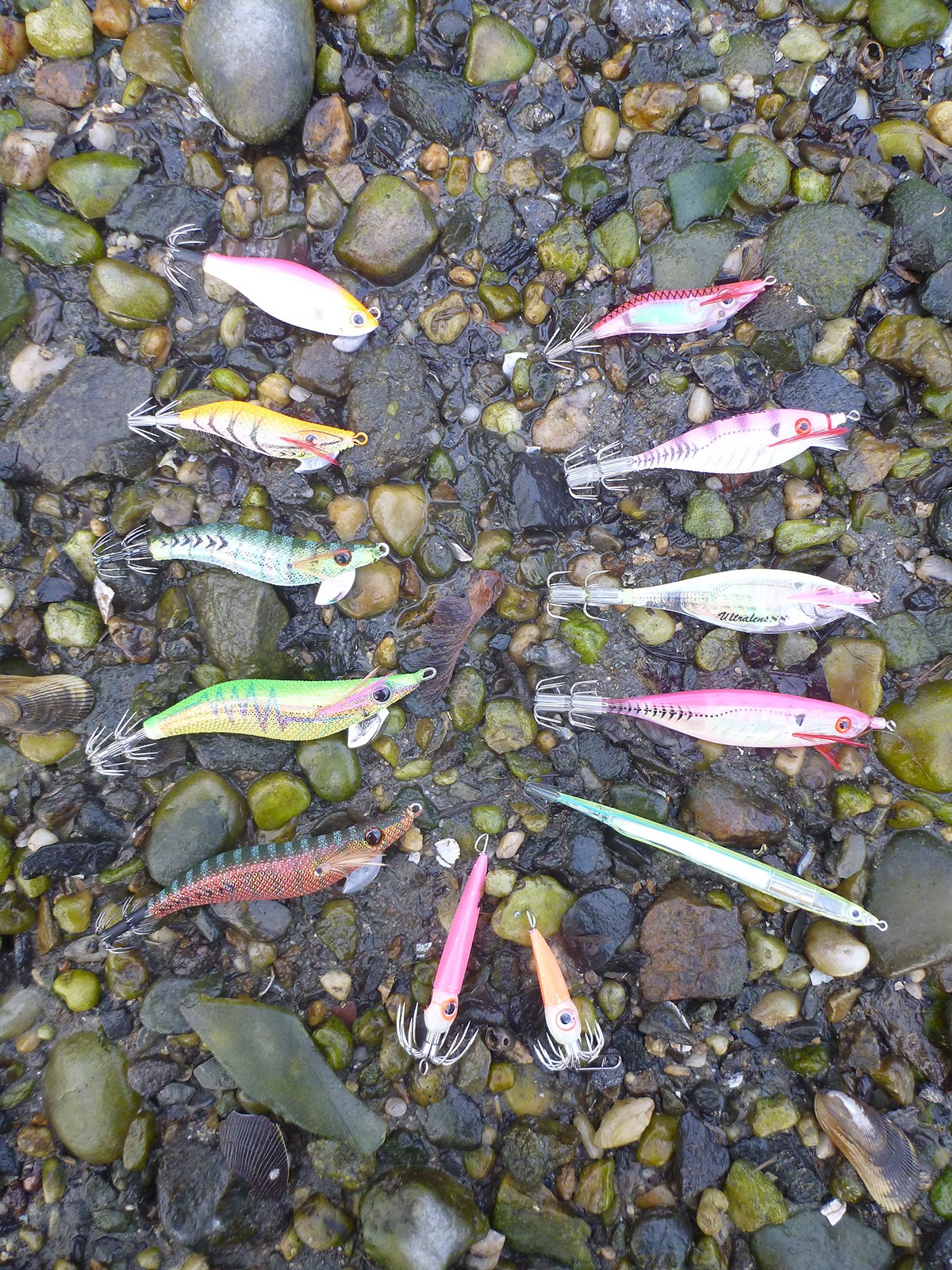
Sinkers: Light Eging
Vertical jigging is a productive method for catching squid in large numbers, but if the squid don’t happen to be swimming right beneath where you’re standing, then you’ve got a problem. No worries, there is always the option of casting for squid. This is where the final type of squid jig I’ll be describing comes into play.
The technique commonly known as light eging was developed in Japan back in the ‘90s. It allows the squid angler access to a much greater range of shoreline locations, freeing one from needing to fish from either a boat or a dock. “Egi” squid jigs, as they are known, can be identified by their asymmetrical bodies and a weight located under the throat that causes them to slowly sink at about a 45-degree angle. Most resemble shrimp, but a growing number imitate baitfish as well. In Japan and Australia light eging is all the rage, and anglers there use specialized, and sometimes very expensive tackle with which to pitch these lures. While I’m sure that fancy tackle is amazing to use, I’ve done quite well using a 7-foot light action spinning rod spooled with 10-pound test braid, topped off with 6 feet of 6- to 8-pound fluorocarbon for a leader. Egi come in a number of sizes, which correspond approximately to the jig’s length in inches from nose to the end of the body, where the spines begin. For our local squid, sizes 2.0 and 2.5 work best.
The key to successful eging lies in the retrieve. Egi should be cast out and allowed ample time to sink to the bottom. This can take 10 seconds or more depending on the water depth. It helps to watch your line pay out until it stops. Next, reel in any slack, point the rod towards the bait, then snap the rod up sharply two to five times to about the 2 o’clock position in rapid succession, reeling in the slack between each snap. Now for the most important part: allow the jig to sink back to the bottom on as tight a line as possible, the goal being for the jig to slowly sink at an angle towards you. The jig must be allowed to settle on the bottom, then, after a pause of a few seconds, repeat the whole process. The snap-jigging motion lifts the jig off the bottom and causes it to dart erratically from side to side, catching the squid’s attention from a distance. Squid will then quickly approach the bait to within striking range and stalk it as it sinks. When the jig comes to rest on the bottom the squid will strike out with its two long tentacles. If you keep a fairly tight line you may feel a faint tap as this happens. That’s the time to quickly but gently raise your rod to set the spikes and hook the squid. Sometimes you may feel multiple taps as the squid tests the lure, as if to see if it’s worth eating, but often you will not feel the squid strike at all. In that case, as soon as you repeat the snapping process you will feel the weight of a squid hanging onto the jig. When you do hook a squid, don’t rush to reel it in, as it may be hooked by only one tentacle and could easily tear free.
Often I start a trip by deadsticking one rod with a vertical rig armed with floating jigs while I cast an egi around in search of squid. When the deadstick gets hit, I switch to vertical jigging. You’d be surprised how readily squid strike a deadsticked rig, especially on windy nights at a floating dock that’s rocking.
With light eging there is the added option of daytime squidding, so if you’re not a night owl, this might be the method for you. While I’ve never had a spectacular catch on a day trip, when the squid are running well I am almost always able to pick a few.
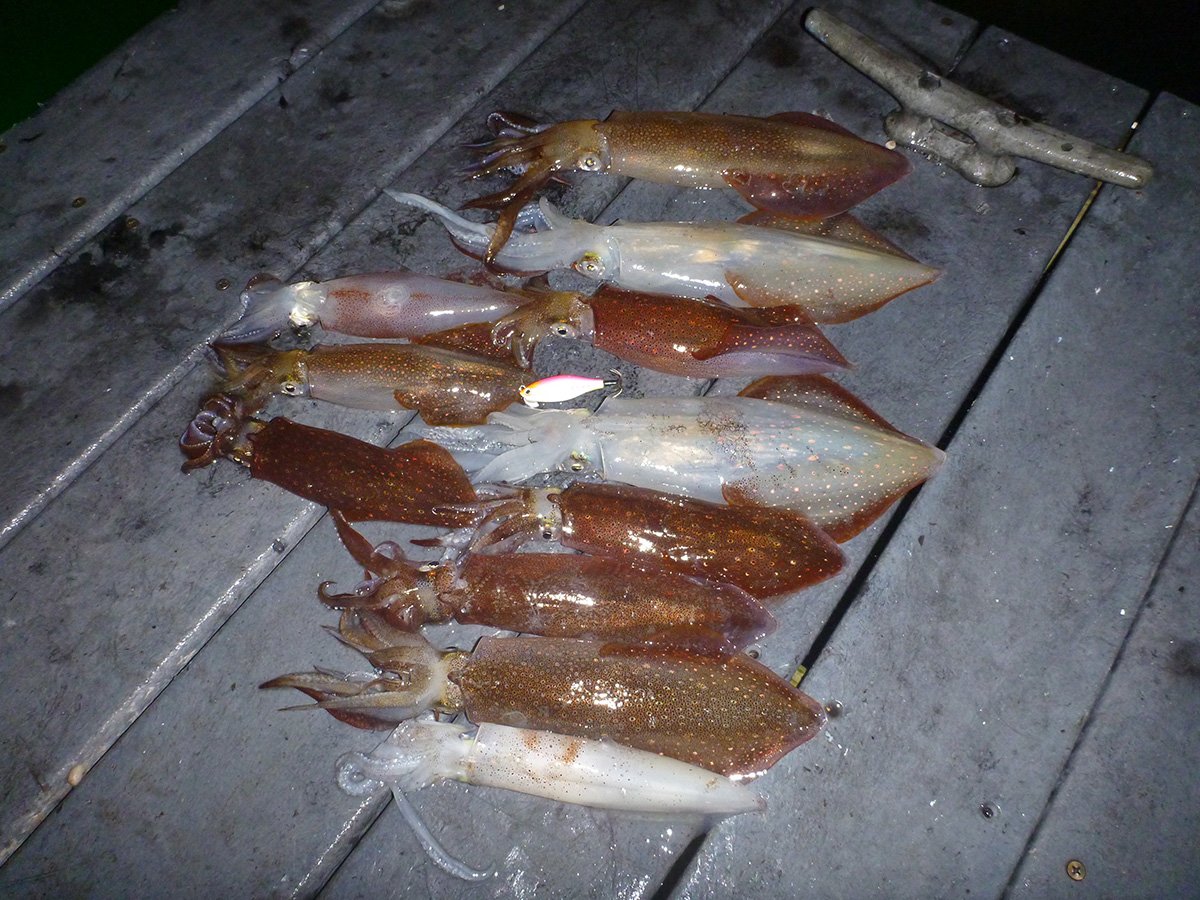
A Word About Color
The subject of color choice in squid jigs could easily take up an entire article, so I’ll do my best to pare it down as much as possible. Fortunately, floating squid jigs tend to come in a fairly standard set of colors. I’ve seen them all work, but by far my favorites are pink and orange. I also prefer any pattern that glows. As for egi, well they come in more shades than any kind of lure I know, so making a simple recommendation is difficult, but I can at least say what has worked for me. I’ve done quite well with pink and orange at night, as well as with purple. In the daytime red tones have been successful for me, as well as patterns that include white. One comment that I’d like to add with regard to color is to not be concerned with trying to match your jig color and pattern to what kind of prey the squid are feeding on. Anytime I’ve ever tried to do this my efforts have failed. If anything, I’ve found that the less realistic, cartoon-character-looking jigs seem to work the best. Taking into consideration that squid have amazing eyesight and that they’re fairly intelligent, I’d venture to say that they like to strike at pretty, sparkly jigs just because they happen to like things that are pretty and sparkly. This may or may not be true, but I think it’s as good an explanation as I’ve heard.
Where-to
Good squid fishing spots are often closely guarded secrets by those who fish them, so you may have to do some exploring to find some of the better locations, unless you can hook up with an experienced squidder. The key is finding docks and piers with some water depth and lights that illuminate the water around the structure. This could be in a marina, boat basin or a public pier. Check with tackle shops in the area you plan on fishing. Any shop that is stocking a reasonable assortment of squid jigs is doing so for a reason and is likely a good source for intel.
There are few local species that can be caught in such abundance as squid, but knowing how to recognize the different types of jigs, as well as how to rig and fish them is essential to success. This fall pick up a few jigs, rig em’ up, and head down to your nearest dock to get in on the action. It’s a great way to end the season.

